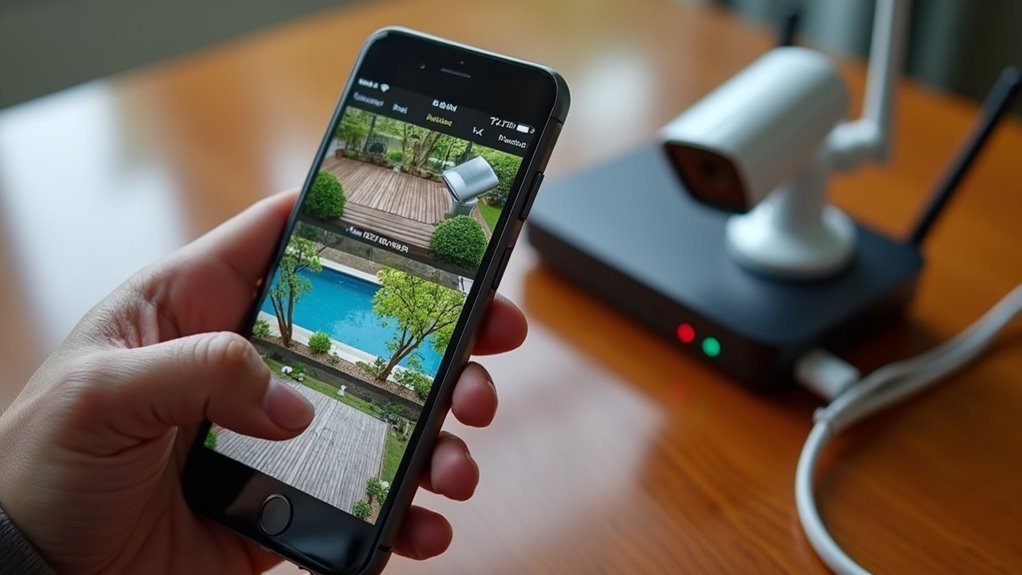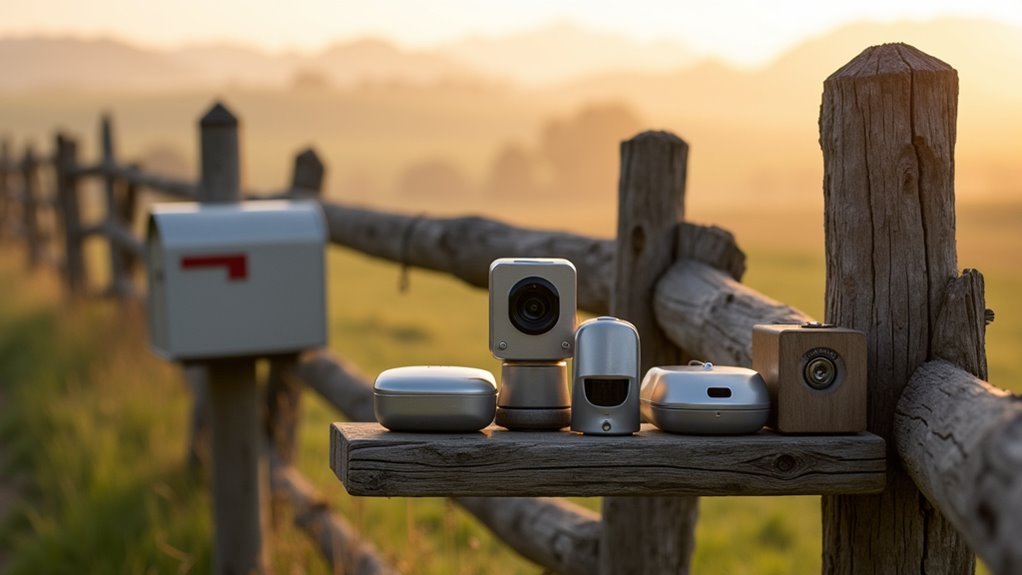You’ve invested in a doorbell camera for security, but if it’s positioned incorrectly, you’re fundamentally throwing money away. The difference between catching a clear shot of an intruder’s face and recording nothing but the top of their head comes down to just a few inches of placement. Most homeowners make critical mistakes during installation that render their expensive security system nearly useless, and you’ll discover exactly what separates effective surveillance from wasted potential.
Optimal Height Placement for Maximum Face Capture

One critical factor determines whether your doorbell camera captures clear, identifiable footage of visitors: its height placement. You’ll achieve ideal height placement by mounting your camera approximately 48 inches from the ground. This installation height guarantees clear capture of both faces and bodies for proper identification.
Avoid mounting too low, as you’ll end up with blurry knee shots and package views instead of faces. Position it too high, and you’ll miss facial features while capturing unnecessary sky footage.
Your camera angle should provide an unobstructed view of the entire doorway and surrounding area. Trim any overhanging branches or foliage that might block the lens.
This strategic positioning maintains consistent image quality and enhances your camera’s effectiveness for security purposes.
Achieving the Perfect 4-Foot Installation Standard
Installing your doorbell camera at exactly four feet from ground level creates the foundation for professional-grade security footage. This installation height guarantees clear visibility of visitors’ faces while preventing awkward low-angle shots of packages or legs.
You’ll achieve proper positioning by measuring carefully from the ground to your camera’s lens, not the mounting bracket. At this height, you’ll optimize your camera’s view to capture wide coverage without missing vital facial details.
The four-foot standard also enhances audio communication quality, positioning the microphone at chest level for natural conversation flow. During installation, you can fine-tune the angle to maintain an unobstructed line of sight to your entrance, avoiding interference from porch overhangs or landscaping elements.
Adjusting Camera Angles Using Mounting Wedges

While achieving the perfect four-foot height establishes your camera’s foundation, fine-tuning the viewing angle with mounting wedges transforms good footage into exceptional surveillance coverage.
When adjusting camera angles, you’ll discover that mounting wedges provide 15 to 30 degrees of tilt, helping you navigate around porch walls and other obstructions for a clearer view.
Experiment with different wedge positions during installation to find your ideal positioning. You’ll want to capture approaching visitors’ faces while maintaining clear sight lines to package delivery areas.
Proper wedge adjustment greatly improves video quality by helping you reduce glare and maximize favorable lighting conditions. This thoughtful angling eliminates background distractions, ensuring your doorbell camera captures crisp, well-lit footage of everyone who approaches your entrance.
Avoiding Common Obstruction Issues
You’ll need to address two primary obstruction challenges that can compromise your doorbell camera’s effectiveness.
First, regularly trim back any vegetation like bushes, tree branches, or overgrown plants that block your camera’s view of visitors and delivery areas.
Second, reposition or shield any nearby light sources that create glare or wash out your footage, ensuring your camera captures clear images throughout the day.
Clear Vegetation Blocking Views
Once you’ve mounted your doorbell camera, vegetation can quickly become your biggest enemy in capturing clear footage. Trees, bushes, and overgrown plants will obstruct your camera’s view if you don’t maintain them properly.
Position your doorbell at 45 inches from the ground to achieve ideal camera angle while avoiding most foliage interference.
Most doorbell cameras feature 160-180 degree fields of view, so you’ll need to trim any greenery encroaching on this range. Adjust your camera angle or use specialized mounts to prevent sunlight glare from reflecting off leaves and branches, which severely impacts footage clarity.
Regular maintenance is essential for your installation guide success. Inspect the camera area monthly and trim vegetation before it blocks your clear view or affects performance.
Relocate Interfering Light Sources
After clearing vegetation from your camera’s view, improper lighting becomes the next major obstacle to quality footage.
You’ll need to relocate outdoor lights that create glare or reflections, as these wash out your video and obscure important details during nighttime recording.
Position lights away from your camera’s field of view at an angle that doesn’t interfere with its line of sight. This strategic placement prevents false motion alerts while maintaining adequate illumination for your property.
Install motion sensors and lights at heights that complement rather than compete with your doorbell camera’s positioning.
Consider using dimmers or adjustable lighting to reduce brightness near the camera.
Regularly assess your light placement to guarantee peak video clarity, adjusting as needed to maintain clear footage both day and night.
Managing Sunlight Glare and Lighting Challenges

While proper placement forms the foundation of effective doorbell camera installation, managing sunlight glare and lighting challenges can make or break your system’s performance.
Position your doorbell camera away from direct sunlight to prevent washed-out images and maintain video clarity throughout the day. Use mounting brackets to adjust the angle of your device, minimizing sunlight glare on the camera lens while ensuring ideal visibility of your entrance.
Install the camera under protective coverage like eaves or porches to shield it from harsh lighting conditions.
Clean the camera lens regularly, removing debris and smudges that obstruct clear footage.
Consider your surrounding environment—tree branches and reflective surfaces can interfere with lighting quality, so position your camera strategically to avoid these obstacles.
Understanding Field of View Coverage Areas
Beyond enhancing lighting conditions, you need to understand how your doorbell camera’s field of view determines what areas you’ll actually monitor and record. Most cameras provide 160-180 degrees of coverage, giving you thorough coverage of your entrance and surrounding spaces.
To maximize your camera’s view effectiveness:
Strategic camera positioning and customized settings ensure you capture essential security footage while eliminating unnecessary alerts from your doorbell camera.
- Position the camera 48 inches off the ground for ideal face and package recording
- Keep the line of sight unobstructed by removing foliage, overhangs, or furniture blocking the view
- Adjust the angle using mounts to reduce sunlight glare and unnecessary motion capture
- Create customized activity zones in settings to focus on important areas
- Filter out irrelevant alerts from passing vehicles or pedestrians
Proper field positioning guarantees you’ll capture what matters most while minimizing false notifications.
Positioning for Package Delivery Monitoring
When installing your doorbell camera for package monitoring, you’ll need to adjust the downward angle to capture the specific area where deliveries are typically placed.
Position the camera to cover the entire package zone while maintaining clear visibility of anyone approaching your doorstep.
Strategic theft prevention positioning guarantees you’ll capture both the delivery process and any suspicious activity around your packages.
Downward Angle Adjustment
Since package theft has become increasingly common, you’ll want to angle your doorbell camera downward to capture clear footage of deliveries at your doorstep.
When you install a doorbell camera, adjusting the camera angle properly guarantees ideal visibility of package deliveries without missing vital details.
Use these techniques for effective downward angle adjustment:
- Position your camera at 48 inches high with a wedge mount directing the view toward the ground
- Angle the camera downward to focus specifically on the package drop-off zone
- Check for obstructions like overhanging eaves or decorative elements that block the view
- Test different angles to minimize false alerts from passing pedestrians and vehicles
- Regularly verify the camera captures packages placed directly in front of your door
Package Zone Coverage
While proper downward angling sets the foundation, you’ll achieve maximum package security by strategically positioning your doorbell camera to create extensive package zone coverage.
Install your doorbell camera four feet above ground to guarantee ideal visibility of packages placed at your entrance. The adjustable wedge included with most devices helps fine-tune your camera’s tilt for thorough coverage without blocking foot traffic.
Configure a dedicated motion zone within your camera settings to focus specifically on package delivery areas. This targeted approach reduces false alerts from passing pedestrians while maintaining vigilant monitoring of your delivery zone.
Regularly review your video footage to verify complete package area coverage. If blind spots exist, adjust your camera placement accordingly to eliminate gaps in surveillance and maximize your package monitoring effectiveness.
Theft Prevention Positioning
Three vital positioning adjustments can dramatically reduce your vulnerability to package theft. Your doorbell camera installation requires strategic placement at chest level, approximately 45-48 inches high, to capture clear facial identification of potential thieves.
This height guarantees ideal angle coverage for both approaching individuals and package deliveries left at your entrance.
Configure these fundamental theft prevention elements:
- Position camera four feet from ground level for all-encompassing package monitoring
- Angle lens slightly downward to avoid sky capture while maintaining entrance visibility
- Remove plants, furniture, or obstructions blocking the camera’s sightline
- Set motion detection zones specifically targeting package drop-off areas
- Confirm clear field of view encompasses entire doorstep where deliveries occur
Proper positioning transforms your doorbell camera into an effective theft deterrent while providing essential evidence if incidents occur.
Angle Adjustments for Different Door Styles
How do you guarantee your doorbell camera captures clear footage regardless of your door’s unique design? This installation guide covers essential angle adjustments for ideal visibility across different entryways.
Mount your doorbell camera at 48 inches for traditional doors to capture faces effectively. For angled or recessed doorways, use wedge mounts to maintain unobstructed views. Position cameras slightly forward when dealing with overhangs to prevent shadows that compromise video quality.
| Door Type | Positioning Strategy |
|---|---|
| Traditional | Mount at 48 inches height |
| Double Doors | Center between both entrances |
| Wide Entryways | Angle to capture entire path |
For double doors, center the camera between entrances at recommended height. With wider entryways, angle your camera to cover the complete entry path while avoiding direct sunlight glare throughout the day.
Eliminating Blind Spots in Your Camera Range
When blind spots compromise your doorbell camera’s effectiveness, strategic positioning becomes essential for extensive coverage. You’ll need to address several factors that create gaps in surveillance.
- Mount at chest level (45-48 inches) to capture clear images of visitors while minimizing obstructions from your doorbell camera’s perspective.
- Choose cameras with 160-180 degree field of view to maximize coverage area and reduce potential blind spots.
- Trim overgrown foliage and branches that obstruct your camera’s line of sight around the entrance.
- Use adjustable mounts to fine-tune angles, avoiding sunlight glare while maintaining ideal visibility throughout the day.
- Review footage regularly and reposition your camera when environmental changes create new coverage gaps.
These adjustments guarantee thorough monitoring without compromising security effectiveness.
Motion Detection Zone Optimization
You’ll need to configure your camera’s motion detection zones to focus on critical areas like walkways and entrances while excluding unnecessary spaces that trigger false alerts.
Start by adjusting the zone boundaries through your camera’s app settings, then fine-tune the sensitivity levels to capture meaningful movement without overwhelming you with notifications.
This optimization process directly impacts how effectively your doorbell camera reduces false alerts from passing cars, swaying branches, or wandering pets.
Zone Boundary Setup
Since your doorbell camera captures everything within its field of view by default, you’ll want to create custom motion detection zones that focus on areas where activity actually matters.
Setting up precise zone boundaries through your camera’s app helps eliminate false alerts from street traffic while ensuring you don’t miss important visitors or deliveries.
- Draw boundaries around your driveway, walkway, and front porch to capture relevant movement
- Exclude busy streets, sidewalks, and neighboring properties to reduce unnecessary notifications
- Adjust zone shapes to follow natural barriers like fences or landscaping features
- Test different boundary configurations by walking through monitored areas
- Fine-tune sensitivity levels within each zone to balance detection accuracy
Properly configured motion detection zones optimize your camera’s monitoring capabilities while extending battery life for wireless models.
Sensitivity Level Adjustment
After establishing your motion detection zones, fine-tuning sensitivity levels becomes essential for achieving the perfect balance between thorough coverage and alert fatigue.
Most doorbell cameras offer multiple sensitivity settings that you can adjust motion sensitivity levels based on your specific environment. When properly installed, you’ll want to position the doorbell to minimize interference from glare or obstructions that affect detection accuracy.
Start with medium sensitivity and gradually adjust based on observed patterns. Higher settings capture subtle movements but may trigger unnecessary notifications from passing cars or small animals. Lower settings reduce false alerts but might miss important activity.
Many modern systems provide tailored alerts by distinguishing between people, vehicles, and pets, allowing you to customize notifications for each detection type and optimize your security monitoring experience.
False Alert Reduction
While sensitivity adjustments provide a foundation for accurate detection, optimizing your motion detection zones represents the most effective strategy for eliminating false alerts.
Doorbell cameras perform best when you configure specific detection areas through your app settings.
- Create focused motion detection zones targeting pathways and doorways while excluding busy streets or sidewalks
- Position your camera’s angle to avoid sunlight glare and moving objects like tree branches or decorations
- Fine-tune sensitivity settings based on patterns you observe in recorded footage over time
- Use two-way audio to verify legitimate alerts and deter potential intruders when motion triggers
- Review and adjust detection zones regularly as seasonal changes affect environmental factors
This systematic approach transforms your doorbell cameras from alert-heavy nuisances into precise security tools.
Preventing False Alarms Through Smart Angling
How can you eliminate those annoying false alerts that interrupt your day with unnecessary notifications?
Start by optimizing your camera angle to focus on your entrance area while avoiding sidewalks and streets where pedestrians trigger unwanted alerts. Position your smart doorbell at 48 inches high to capture clearer images of visitors and reduce detection of small animals below the camera’s sight line.
Angle your device away from direct sunlight to prevent glare that disrupts motion sensing.
Set up customized motion detection zones in your camera’s settings to filter out high-traffic areas. You’ll prevent false alarms by regularly reviewing and adjusting sensitivity settings to fine-tune your doorbell’s responsiveness to minor disturbances in your monitored zone.
Weather Protection and Angle Considerations
Since weather conditions can greatly impact your doorbell camera’s performance and longevity, you’ll need to strategically position it where natural shelter exists.
Finding the right balance between weather protection and ideal viewing angles requires careful planning.
- Choose a sheltered location under eaves or porch overhangs to shield from direct rainfall and wind
- Angle the camera slightly downward to reduce sun glare while maintaining a clear view of visitors
- Install weather-resistant covers or enclosures to protect against harsh weather elements like snow and extreme temperatures
- Position away from harsh weather elements that could damage internal components over time
- Inspect the camera regularly for water damage, debris buildup, or lens obstruction that affects image quality
Proper positioning guarantees reliable operation year-round.
Testing Your Camera Angle Before Final Installation
After positioning your camera with weather protection in mind, you’ll want to verify the placement delivers perfect coverage before making it permanent.
Begin testing by temporarily mounting your doorbell camera and connecting it to Wi-Fi. Use your smartphone to monitor the live feed while simulating visitor approaches from different angles.
Focus on capturing faces clearly without excessive sky or ground in the frame. Adjust the camera angle to eliminate sun glare that washes out footage. Check for obstructions like tree branches or porch overhangs that block visibility.
Your camera should capture both the immediate doorway area and a wider detection zone for approaching visitors.
Make necessary adjustments during this testing phase before final installation to guarantee peak performance and coverage.
Fine-Tuning Angles After Initial Setup
Once you’ve completed your initial testing phase, fine-tuning becomes essential for achieving peak doorbell camera performance. During installation, you’ll need to adjust your camera angle systematically to enhance visibility and eliminate problematic areas.
- Adjust positioning with mounts or brackets when initial footage reveals missed detection zones or coverage gaps.
- Review captured footage regularly to identify blind spots that require immediate attention and repositioning.
- Experiment with tilt and rotation settings to improve your field of view and cover entire entryways plus pathways.
- Minimize glare and obstructions by repositioning away from direct sunlight and foliage interference.
- Fine-tune angles seasonally to maintain ideal visibility as lighting conditions and vegetation change throughout the year.
This ongoing enhancement guarantees your doorbell camera delivers consistent, reliable security coverage.
Frequently Asked Questions
What Is the Best Position for a Smart Doorbell?
You should mount your smart doorbell at 48 inches high, at chest level, with an unobstructed view of the entrance. Avoid placing it under overhangs and adjust the angle to prevent glare.
What Height Should a Doorbell Camera Be Mounted?
You should mount your doorbell camera at approximately 48 inches from the ground. This chest-level height guarantees you’ll capture clear views of visitors’ faces and bodies while avoiding awkward knee-level shots.
Where Is the Best Place to Put a Doorbell Camera?
You’ll want to mount your doorbell camera beside your front door, ensuring it’s got an unobstructed view of visitors. Position it where there’s no foliage blocking sightlines and minimal shadows from overhangs.
What Is the Best Position for a Ring Doorbell?
You’ll want to mount your Ring doorbell 4 feet high and angled slightly downward. Avoid direct sunlight, overhangs, and obstructions. Use wedge mounts if needed for better facial recognition and package visibility.





Leave a Reply